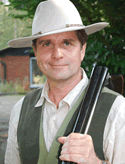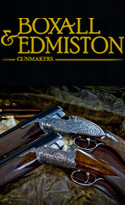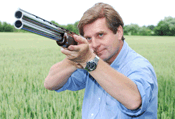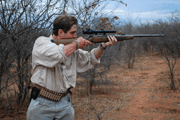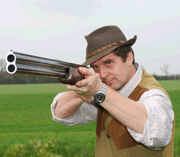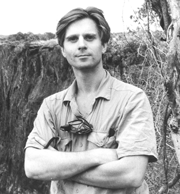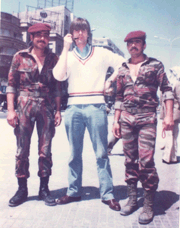GunMount For Clays Shooters
Really good clayshooters often practice their gunmount every day. Gun-mounting is a fundamental of shooting technique. Many, including some comparatively successful shots, handicap themselves and limit their ultimate progress, because they have never really learnt to mount a gun well. If you want to achieve your full potential, you must work on, and perfect, your gun mount. It should be smooth, unrushed, and both hands must work together. If you shoot gun down, as I would advise you do for most sporting targets, the mount should be carried out to three beats, but with the tempo changing depending upon the speed and angle of the shot. A close quartering bird, if taken out of the shoulder, is a rapid ONE: TWO: THREE shot. A long crosser is taken at a slower pace ONE.....TWO....THREEEEEE.
Body movements, a subject we discuss in more detail here, should be co-ordinated with the mount. You will rarely be required to mount the gun alone, usually you will have to swing the gun too. So, we might distinguish between a simple mount for a straight going away shot or incomer, and the more common mount and swing required of the average crosser. It is, in fact, a swing and mount to be precise, as the swinging motion should usually begin before the mount. I start to rotate my body, and especially my upper body, before the mount commences as I begin to move with the target and bring my muzzles to it in a gun-down position. Typically, I complete the mount on the back edge and push forward as I apply forward allowance (usually an unconscious process for me until shots are taken at longer ranges).
All of this might beg the question should one shoot gun-up or gun down? 99.9% of trap shooters (unless they are taking part in ‘Hunter’s Clays’ as used to be and may still be shot in Scandinavia) will shoot gun-up. They still have to mount the gun, of course, and doing it well is critical to success, but they call for the clay with the gun in the shoulder. I don’t suggest you do otherwise. Gun-up shooting makes trap targets significantly easier. For trap, I usually mount my gun into space about 30 degrees above the trap house and bring my gun down onto my hold point. I also use a gun-up style, rules permitting, for trap-like targets on a sporting range, and, most going away, quartering, and/or low going away targets. Gun-up also works very well for teal.
My normal advice for teal, if you shoot both eyes open, is to mount onto the intended break point and come exactly half way down the flight line of the target. If you shoot with one eye, you will need to bring the gun back down, or nearly back down, to the trap to improve your visibility. This makes the point that gun down shooting makes seeing the target easier, and also tends to improve timing, but, it takes a little more time and risks a mid-shot glitch (so make sure your stock is not too long and you pad – if you have one – not too sticky).
Domestic or NSSA skeet may be shot gun-up or gun-down, most of the really big scores are shot gun-up, though my preference is for gun-down shooting (as used to be required many years ago). I also believe that everyone should learn to shoot gun down because it is such a useful technique with so many applications. Of course, there are a lot of variations – from the Olympic skeet method with the butt down at the hip, to FITASC with the butt below the ‘nipple line,’ to having the gun just out of the shoulder before the call (my own normal preference at English Sporting).
There are some basic principles with any mount, though. The butt should always be brought to the face, the gun should not be pressed to the shoulder first with the head coming down afterwards. I often tell people to bring their chins down a little before they start the mount and throw their focus forward – I call this the bird of prey position. Another basic is that the head should not move as you mount the gun. To prove to you why this is important, stand up now. Focus on something and point to it with an extended arm and finger. Now, try it again and deliberately move the head as you point. You will discover that it mucks you up completely and destroys all natural co-ordination.
The comb of the stock should come to the face comfortably. It locates under the cheek-bone in what is called the zygomatic arch – a ridge of bone extending back to the ear. The head should be kept down during the mount (indeed, all the way through the shot). BUT, you should not force the head or face down onto the wood, all that is required is positive contact. If you push the head down excessively, it creates tension, and, as I have often say: tension is the enemy of good shooting.
Where should the muzzles and stock butt start start? Advice varies. Percy Stanbury noted the barrels should be kept well up with muzzles just under the line of sight. The top of the stock should be more-or-less parallel with the forearm of the rear arm. This is a classic starting position, but, practically speaking it is too low to the rear and, arguably, too high to the front, in a lot of circumstances as far as sporting clay pigeon shooting is concerned. Robert Churchill taught a quite different and most distinct technique. His advice was that the butt should be brought back and under the shoulder. The muzzles should be held much lower - parallel to the line of sight. It looks most odd to the uninitiated. I also note, and often use, a hybrid method where the butt is brought under the armpit, but the muzzles are held higher – just below the line of sight.
Biddy in his MOVE:MOUNT: SHOOT technique suggests a starting position for the muzzles that is roughly speaking half way back along the line of flight and half way down (halfway between the ground and flight-line). This is a most interesting technique and well worth experimenting with whether or not you are routine maintain-leader.
In the case of a Stanbury style mount the gun will pivot about the axis of the muzzles as the mount progresses, it will also be pushed towards the target with the shoulder going forward to meet it as the mount is completed. In the case of the Churchill mount there is a much more exaggerated pushing out of the gun as the mount commences and a less obvious movement of the shoulder to the gun at the end (although Churchill might have argued the point). It tends to ensure a snag free mount without dragging of the butt sole against the pectoral muscles and shoulder.
I use both styles for teaching purposes and various things in between! If I was to argue the merits of the classic approaches, I might note that the Stanbury technique is more generally useful, but the Churchill method, or, a modification of this that brings the butt under the armpit but keeps the muzzles up, is excellent for anyone who is having problems with consistent gun mounting. It ensures that the gun is properly positioned at the face and shoulder when the mount is completed. I often use the Churchill mount as a teaching aid before progressing to other things. It is also useful for remedial work with those who have mounting problems.
Where should the gun come to at the shoulder? It is often said that the sole of the butt must come to the 'shoulder pocket', that is the natural pocket between shoulder joint and collar bone. For some, this may be sound advice, but a number of very good shots, mount their guns on or partially on the shoulder joint. Not only do I have no problem with this. I do it. It works perfectly well. Mounting the gun on the upper arm, however, as will happen if your length of pull is excessive or if you are inexperienced or in a bad habit is an absolute sin. It will lead to discomfort and bruising as well as a lack of control.
When learning or teaching the mount, the importance of front arm control should be emphasised (especially in the sporting context). You must not rush. The muzzles should not rise above you line of sight. This will require some effort from the front arm. The rear hand must not dominate the mount. An effort should be made as the mount progresses to control the muzzles with the front hand. Many rush the mount and complete it far too early in the swing. This leads to a 'mount and slash' style of shooting which not only looks horrible but destroys control and consistency. Another common problem is 'cartwheeling' where one allows the gun to pivot about the axis of the front hand. The cure as already noted, is better use of the front hand. The perfect mount, let me make clear, requires both hands to work in unison.
If you want to improve your shooting, you are well advised to practice your dry mount as much as you can with a proven empty gun. Practice the simple mount, and the swing and mount combined. I sometimes use an Arrow Laser shot pointing device. It’s an excellent device and useful for gunfitting too. Some people practice their gun mount with weighted barrels. To save the bother of unlocking a cabinet, I keep an antique shotgun, in my living room, just for mounting practice. If I could afford it, I might acquire one of the excellent computer simulators now available – the ‘Marksman Training System’ from Sweden is an extraordinary piece of virtual reality kit.
Meantime, I advise that you practice your gun mount on a clay range as well and experiment. If you have a friend who has a poor mount, advise they try the Churchill way, it is very useful for early stage instruction and for remedial work. If you shoot gun down now, try and master gun down shooting. If you do, I suspect that you will discover that there are horses for courses. I shoot 90% of sporting targets with the gun just out of the shoulder, for the other 10%, the trappish birds and teal as noted, shooting gun up is a real advantage in my opinion.
As for skeet, and I am a recreational skeet shooter only (though I love the discipline and shoot quite a lot of it), I shoot most birds gun down with the exceptions of: High 1 (the over-head); High 2 (where I usually mount the gun on a break point above the central point of the range and bring the mounted gun exactly half way back along the flight line), and, Low 7. All my serious trap shooting is gun down, but, occasionally, just for interest, I will have a go at DTL gun down – it’s a completely different sport! As with stance and everything else, don’t take my word for any of this, experiment and have fun! One final point, check your eye dominance out, undiagnosed eye dominance issues can play havoc with gun mounting. More on eye dominance here.


